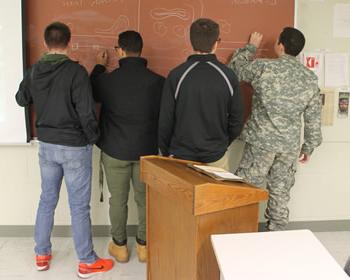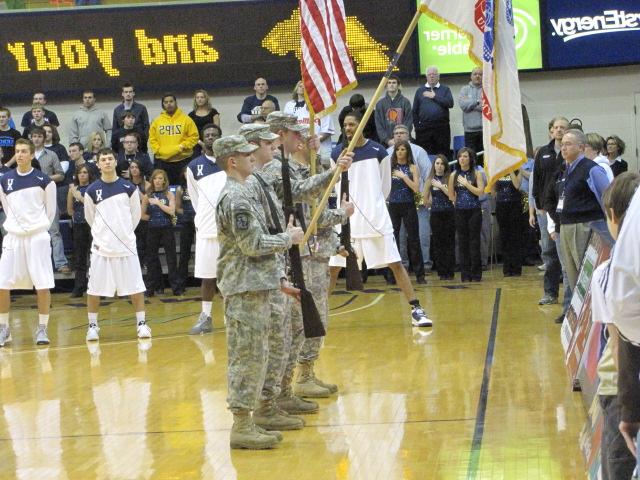Cadet Life Here at the University of Akron
Historically, an average cadet may take around 15 credit hours. However, some others may take anywhere from 12 to 20 credit hours.
Depending on your major and your graduation year, this number can vary significantly. Here at the University of Akron Army ROTC, we do not recommend students to "course overload" which is typically anything over 15 credit hours. This is due to the heavy demands it places on the students and historically always ends up with the cadet dropping a class or two.
If you plan and follow your course requirements by utilizing the Planned Academic Worksheet (CC-104R), this can mitigate a lot of issues such as taking a semester full of core classes.
Although this question may seem simple, many students who are new to college or have been out of school may wonder what a college students daily life may be like.
On a day to day basis, students will normally attend their required courses while adding studies and meals in between classes. Depending on your course load, a student may take classes back to back or have breaks consisting of an hour or two in between classes.
A typical student normally takes anywhere between 12 to 15 credit hours of college courses. These courses may consist of general education classes in addition to classes that may fulfill his or her area of studies requirements.
With this being said, a college student may take an average of 1 to 4 classes spread throughout the day. Typically, classes can start as early as 7:45 am all the way through 10 at night. Class lecture times can be anywhere from 50 to 90 minutes.
 ROTC classes consist of different course lectures depending on the Military Science Class Level.
ROTC classes consist of different course lectures depending on the Military Science Class Level.
Generally, MS-I and MS-II classes are an introduction to the basic Army ways. These classes can consist of introduction to the military rank structure all the way down to the fundamentals of military leadership.
MS-III classes* consist of small unit leadership typically at the team, squad, platoon, and company size elements. In addition, MS-III cadets focus on receiving, writing, and delivering squad and platoon operations order. They also work on refining their land navigation skills in addition to preparing themselves to successfully complete the Leader Development and Assessment Course or also known as Warrior Forge at Joint Base Lewis-McChord in Washington during their junior year.
Military Science Labs are focused on training the MS-III cadets to develop and fine tune their small unit leadership skills. For the MS-I and II cadets, this is the time that they utilize what they have learned in class and put it to the test out in the field. Whether this would consist of preparing their swiss seats in order to rappel off a rappel wall or conducting land navigation out in the woods of Ravenna. Many students will find that the military leadership labs are more hands on and tests the individuals on what they have learned inside the classroom.
* MS-III and MS-IV classes require a department consent to enroll if the student has not completed the MS-I or II courses.
Extracurricular Activities and Organizations
RANGER COMPANY
Ranger Company is a co-curricular campus organization dedicated to the development of individual leadership abilities through the application of the principles of leadership. It further develops the skills through the planning and execution of Warrior Tasks. Ranger Company allows for cadets to get more hands on experience and be better prepared for LDAC, LTC, and real world military situations. We use the knowledge and experiences of Cadre and cadets to improve our leadership capabilities both in and outside the program. The program originated in 1963 Major Eital Banks formed the “Counter guerillas.” The purpose of the organization was to gain additional training in the field and combat techniques. The black beret was chosen to distinguish the cadets of the organization from the average cadet. The flash resembled the infantry patch, containing a bayonet and the inscription “follow me” (now the training cadre patch of Fort Benning). Through the years, the organization was shaped and molded into a revamped association that promotes excellence in the classroom and in the field.
 SUMMIT RIFLES
SUMMIT RIFLES
The organization Pershing Rifles is not new to Cadets or the University of Akron. This organization was formed originally in 1981 by the now well known General John Joseph Pershing at the University of Nebraska. At the early point in this officer’s career then Lieutenant Pershing formed the original organization, previously named Varsity Rifles, in order to raise morale. Since this early day Pershing Rifles continues to be a well renowned drill team which uses military customs and expert drills to teach discipline to future officers. This discipline is displayed around the University of Akron through the many events the Akron chapter of Pershing Rifles participates in. These events can range from posting the colors at Akron’s sporting events to honoring those who have served by military displays on campus during Veteran’s Day.
